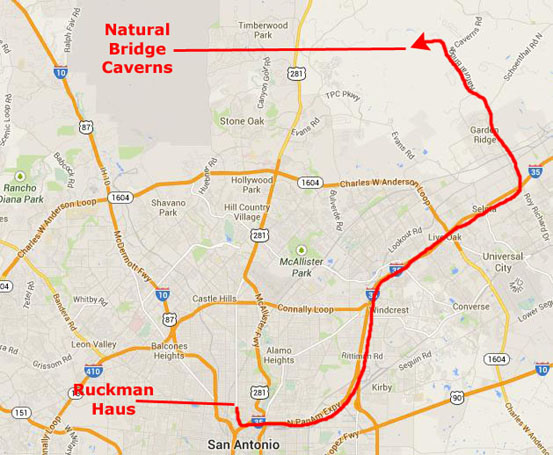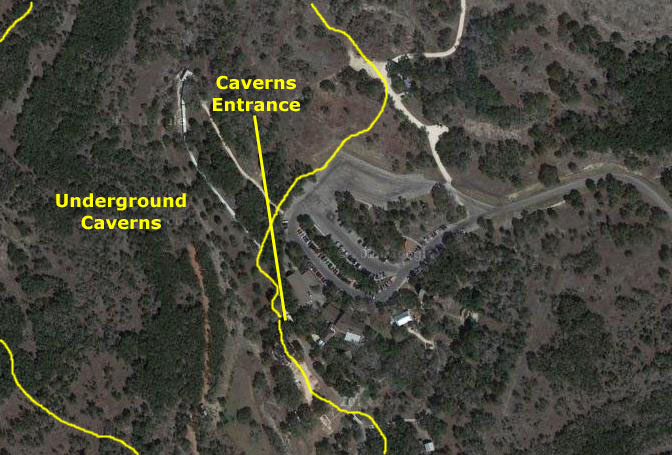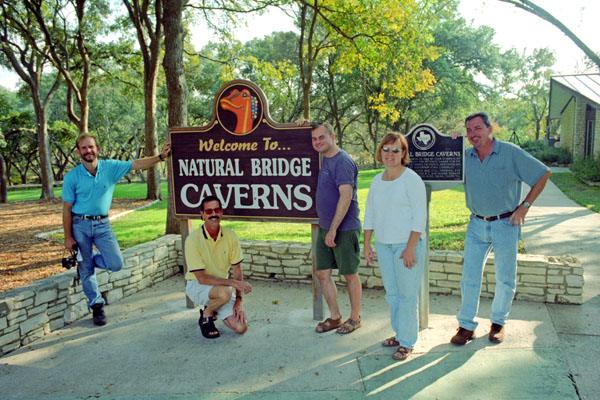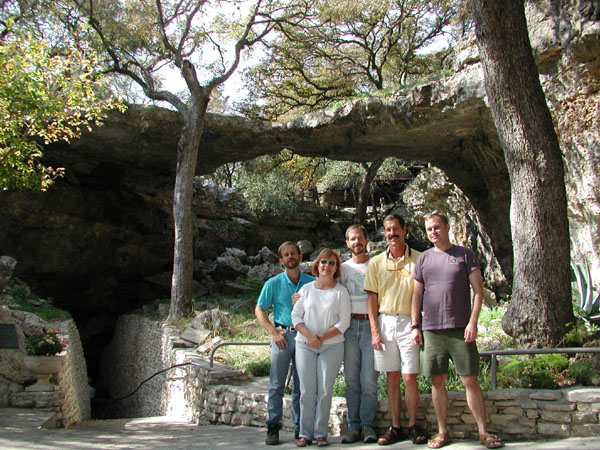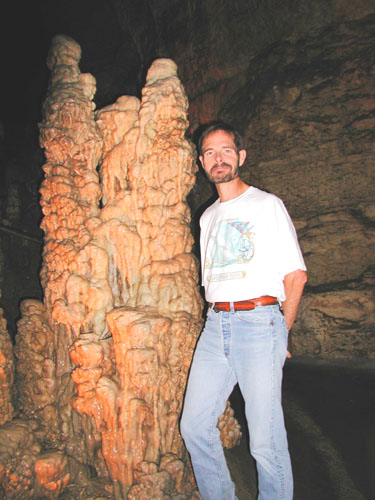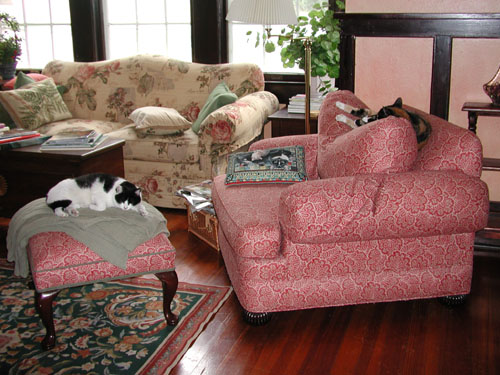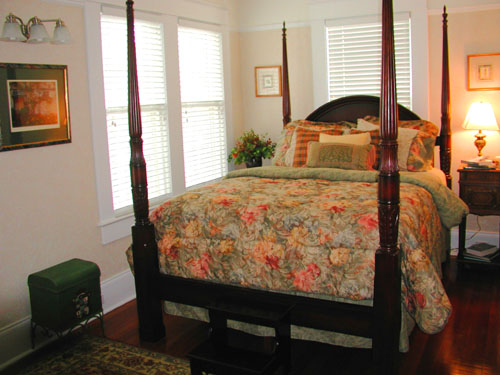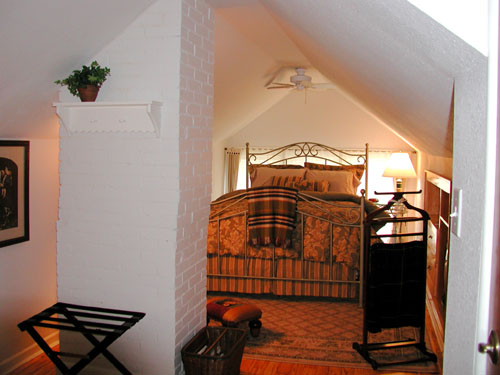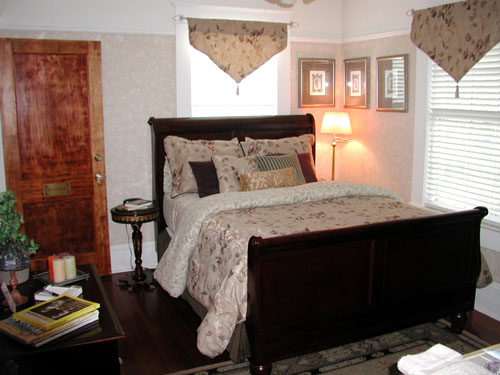
A Unique Bed & Breakfast In the Heart of San Antonio's Historic District
Well, all the work that Prudence and Ron Ruckman have been doing to get their bed and breakfast ready for operation is coming to a head. This weekend, Fred and I have come down to San Antonio so that I can take some pictures for the Web site that I am developing for Ruckman Haus, and also so that we can spend some time with Prudence, Ron and Guy Blair, my friend who has been transferred to San Antonio to be the priest for San Francesco di Paolo Catholic Church. After spending Friday and Saturday nights with Prudence and Ron, we are going to drive out to Leakey, Texas, to spend a day with Frank Roberts and Joe Wells.
Natural Bridge Caverns
It is only a short drive up I-35 to the exit for Natural Bridge Caverns, which is about five miles northwest of the Interstate.
We took a few other group shots at the entrance to the caverns, and you can use the clickable thumbnails below to have a look at them:
The caverns are located right at the edge of the Texas Hill Country next to the Natural Bridge Wildlife Ranch, a drive-through wildlife safari park. The caverns feature several unique speleothems and other geological formations. The temperature inside the cave is 70°F year-round and the humidity rate is a constant 99 percent. The deepest part of the public tour is 180 feet below the surface, although undeveloped areas of the cavern reach depths of 230 feet.
We waited a few minutes in the Visitor Center for the next tour to begin, and then went with our guide and a few other folks out the back of the building and down a winding walkway to
the amphitheatre
down below the natural bridge.
The caverns were discovered in 1960 by some students from St. Mary's University in nearby San Antonio; they discovered/explored just over a mile of passages. Subsequent explorations revealed 2 miles associated with what became known as the "North Cavern."
After discovery, one of the former students, Orion Knox, assisted the landowner in her desire to show the world the cave under her property, but both the National Park Service and the Texas Park System, while agreeing that the cavern was substantial and merited development, said they did not have the funds for the process. The owner, a Mrs. Wuest, then decided that she would fund the development, and Orion dropped out of school to assist. They roped in the developer of the Caverns of Sonora (near Sonora, Texas), and for extra help, Mrs. Wuest remarried her ex-husband. Development on the cavern began in 1963 and work on lights and trails continued until opening day, July 3, 1964. The cavern is still owned and operated by family members and has been a registered United States National Natural Landmark since 1971.
After the introduction given us by our guide, our group headed through the entrance door into the caverns. Since the cave is still "alive," the entrance door is a double one, constructed to keep humidity from escaping.
During excavation of the entrance trail, a human tooth, arrowheads, and spearheads dating from 5,000 BC were found. Also, just inside the entrance, a jawbone and femur from an extinct species of black bear were discovered. This leads many to believe that uppermost areas of the cavern were used as a shelter by early peoples and animals at some point. An archaeological dig was recently done under the natural bridge. Archaeologists recovered arrowheads and other tools which further indicate the presence of early peoples at some point in history.
In 1967, speculation on a southern extent to the North Cavern was confirmed when test drilling indicated the presence of a large void approximately 90 feet beneath the surface. A camera was sent down the narrow shaft and photographs revealed a large chamber filled with formations. This original shaft was reamed out to 22 inches and three men were lowered into the ground. They discovered a large breakdown chamber and numerous formations. Further investigation revealed a strong likelihood that another passage existed beyond a pile of rocks and boulders. In 1968 the drillers were once again brought out to the property, a 200-foot exploratory shaft was sunk, and another large void discovered. Explorations revealed another half-mile of cavern extending to the south- the "South Cavern."
Exploration continues to date. During the summer of 2005, several hundred feet were added to the current surveyed length of the cave. It is believed that as much as another mile could be added to the survey by just mapping the known passages which have not yet been surveyed. Additional unexplored leads exist in sections of the Discovery Passages (North Cavern). Our tour took us through about half the cave, and it was very interesting. Use the clickable thumbnails below to see the other pictures we took here in Natural Bridge Caverns:
At Ruckman Haus
You may have noticed in the picture of the living room Prudence's two cats- the black-and-white Callie and the calico Misty-
asleep on the chair and footstool.
Prudence has not had a chance to do much with her plans for the East Garden yet, but has instead brightened up the outside of the house with many
potted flowers,
all of which seem to be doing quite well.
After spending most of the day with Ron and Prudence, Fred and I drove from San Antonio over to Leakey, Texas, for a visit with Fred's good friends Frank Roberts and Joe Wells.
|
||||||||||||||||||||||||||||
|
Ron and Prudence Ruckman
stay@ruckmanhaus.com |



